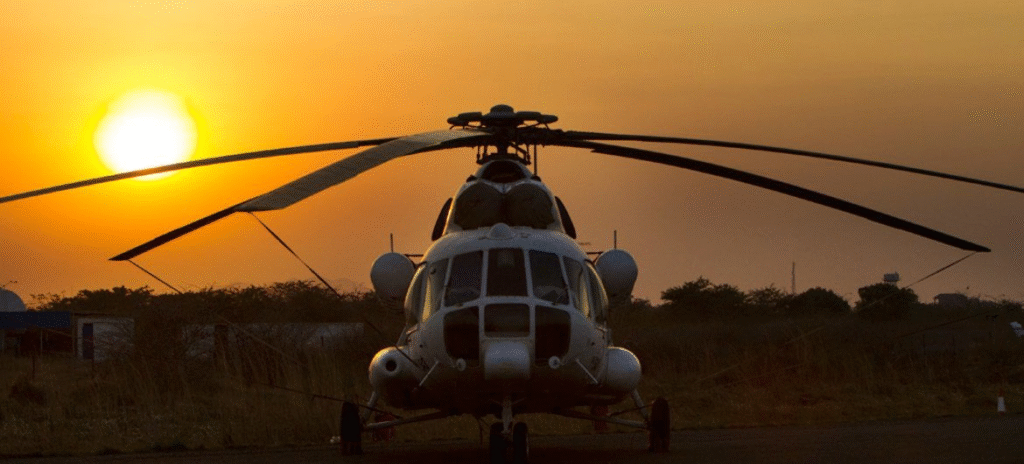South Sudan has increasingly relied on Mi-17 transport helicopters to support peacekeeping and stabilization missions within its borders. These aircraft have become essential tools for the country’s post-conflict recovery efforts, particularly in reaching remote regions affected by insecurity, intercommunal violence, and humanitarian crises. As South Sudan continues its fragile transition from civil war to peace, the Mi-17 fleet plays a vital role in delivering personnel, aid, and logistical support where traditional ground transport proves difficult or impossible.

Rebuilding After Conflict
- South Sudan emerged from years of civil war following the 2018 Revitalized Agreement on the Resolution of the Conflict in the Republic of South Sudan (R-ARCSS). Although the peace deal helped reduce major hostilities, pockets of violence and insecurity have persisted, especially in rural states such as Jonglei, Upper Nile, and Unity. The country’s underdeveloped road network, seasonal flooding, and widespread displacement have posed significant challenges for delivering peace support and humanitarian assistance.
- To address these obstacles, South Sudan’s government, with support from international partners, has expanded the use of rotary-wing assets—most notably the Russian-made Mi-17 transport helicopter. These platforms have proven invaluable for both military and civil operations, including the deployment of peacekeeping troops, evacuation of civilians, and delivery of life-saving aid.
The Mi-17 Helicopter: A Workhorse in Difficult Conditions
- The Mi-17 is a medium-lift helicopter developed by Russia and widely used around the world due to its durability, versatility, and ability to operate in rugged conditions. In South Sudan’s context, the aircraft is well-suited for missions in flood-prone, forested, or mountainous terrain where runways are nonexistent and ground access is severely restricted.
- South Sudanese forces have used Mi-17s primarily for transport roles, moving peacekeepers, police units, and supplies to high-risk areas that require a sustained government or security presence. Their use has also helped project authority into distant regions where armed groups or local militias remain active, helping reduce tensions through visible state presence.
- In addition to security missions, Mi-17s have been adapted for civil support tasks such as aerial medical evacuation (MEDEVAC), transportation of electoral materials, and flood relief operations. Their capacity to carry large cargo loads or up to 24 passengers makes them a reliable multi-role platform in both crisis and development contexts.
Supporting Peacekeeping and Civil-Military Operations

- The Government of South Sudan has increasingly coordinated its Mi-17 operations with international peacekeeping efforts, particularly under the United Nations Mission in South Sudan (UNMISS). While UNMISS maintains its own fleet, coordination with South Sudanese forces—particularly during joint patrols and rapid deployments—has strengthened interoperability.
- Mi-17 helicopters have been instrumental in deploying South Sudan People’s Defence Forces (SSPDF) units to buffer zones, de-escalation sites, and conflict-prone regions as part of ceasefire monitoring and confidence-building measures. In some cases, they have also transported members of the Joint Transitional Security Committees to areas where peace monitoring is taking place.
- The aircraft’s presence has improved rapid response capacity, helping national and international actors respond more effectively to outbreaks of violence or natural disasters. In remote parts of the country where local grievances can quickly escalate, helicopter-enabled missions have made it possible to mediate disputes, deliver services, and de-escalate tensions.
Maintenance, Training, and External Support
- Maintaining and operating the Mi-17 fleet has presented significant logistical challenges for South Sudan. To address this, the government has partnered with foreign contractors and technical advisers to support maintenance, pilot training, and spare parts procurement. Countries such as Russia and Ukraine, both of which manufacture components for the Mi-17, have been involved in technical assistance and periodic servicing.
- Pilot training has taken place both domestically and abroad, with select South Sudanese personnel attending aviation programs in East Africa and Eastern Europe. These efforts are gradually building local aviation capacity, though the sector still relies heavily on foreign expertise.
- UNMISS and humanitarian organizations have also engaged with South Sudanese authorities to coordinate air operations and ensure that peacekeeping and relief flights do not overlap or conflict with national missions. This coordination is especially important in times of emergency, when multiple actors may need access to the same air corridors or landing sites.
A Tool for Stability and Nation-Building
- As South Sudan continues its fragile path toward peace and stability, the strategic use of Mi-17 helicopters will remain essential. These aircraft provide a lifeline for communities isolated by conflict, geography, or environmental challenges. Their continued operation will be critical for supporting election logistics, peace agreement implementation, and delivery of public services in hard-to-reach areas.
- There is also potential for the Mi-17 fleet to play a greater role in regional humanitarian support, especially in neighboring countries facing similar logistical challenges. As South Sudan’s air capability matures, the helicopters may contribute to African Union or IGAD-led missions across the region.
Conclusion
South Sudan’s use of Mi-17 helicopters has become a cornerstone of its peacekeeping and humanitarian strategy. These aircraft bridge the gap between fragile ground infrastructure and urgent needs in remote areas, supporting both national security and civilian recovery efforts. With sustained investment in maintenance, training, and coordination, Mi-17s will continue to serve as a vital asset in building peace and resilience in Africa’s youngest nation.


